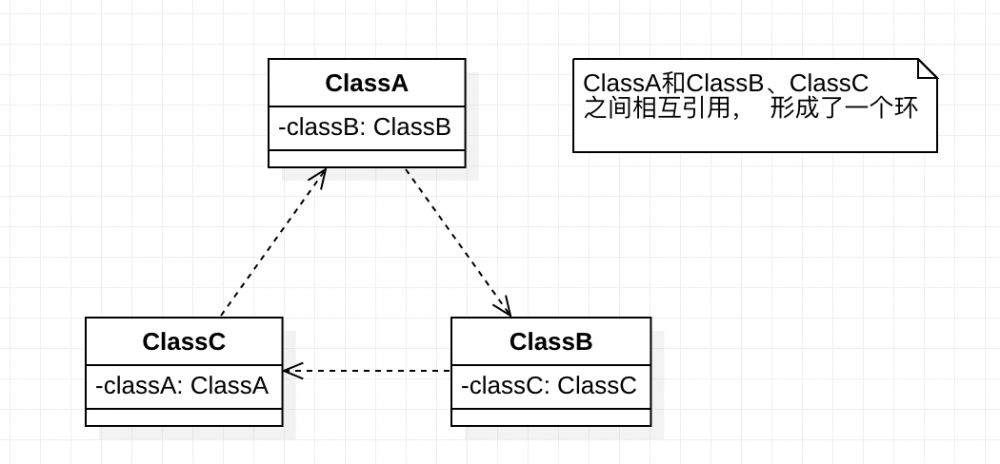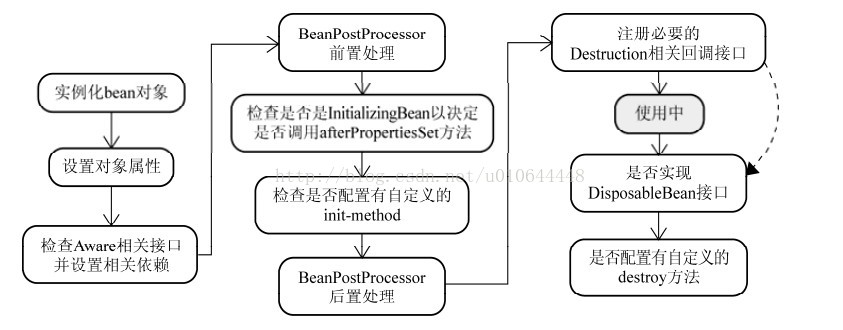什么是循环依赖?
循环依赖其实就是循环引用,也就是两个或则两个以上的 Bean 互相持有对方,最终形成闭环。比如A依赖于B,B依赖于C,C又依赖于A。如下图:

如果在日常开发中我们用new 对象的方式发生这种循环依赖的话程序会在运行时一直循环调用,直至内存溢出报错。下面说一下Spring是如果解决循环依赖的。
注意,这里不是函数的循环调用,是对象的相互依赖关系。循环调用其实就是一个死循环,除非有终结条件。
根据 spring 中 Bean 的注入方式:构造器注入方式,属性注入方式(单例和多例),我们分别来讲解循环依赖的处理方式。
构造器参数循环依赖
Spring容器会将每一个正在创建的 Bean 标识符放在一个“当前创建Bean池”中,Bean标识符在创建过程中将一直保持在这个池中,因此如果在创建Bean过程中发现自己已经在“当前创建Bean池”里时将抛出BeanCurrentlyInCreationException异常表示循环依赖;而对于创建完毕的Bean将从“当前创建Bean池”中清除掉。
首先我们先初始化三个Bean。
**StudentA **
public class StudentA {
private StudentB studentB ;
public void setStudentB(StudentB studentB) {
this.studentB = studentB;
}
public StudentA() {
}
public StudentA(StudentB studentB) {
this.studentB = studentB;
}
}
**StudentB **
public class StudentB {
private StudentC studentC ;
public void setStudentC(StudentC studentC) {
this.studentC = studentC;
}
public StudentB() {
}
public StudentB(StudentC studentC) {
this.studentC = studentC;
}
}
**StudentC **
public class StudentC {
private StudentA studentA ;
public void setStudentA(StudentA studentA) {
this.studentA = studentA;
}
public StudentC() {
}
public StudentC(StudentA studentA) {
this.studentA = studentA;
}
}
OK,上面是很基本的3个类,StudentA 有参构造是 StudentB 。StudentB 的有参构造是 StudentC,StudentC 的有参构造是 StudentA ,这样就产生了一个循环依赖的情况,我们都把这三个 Bean 交给 Spring 管理,并用有参构造实例化。
<bean id="a" class="com.zfx.student.StudentA">
<constructor-arg index="0" ref="b"></constructor-arg>
</bean>
<bean id="b" class="com.zfx.student.StudentB">
<constructor-arg index="0" ref="c"></constructor-arg>
</bean>
<bean id="c" class="com.zfx.student.StudentC">
<constructor-arg index="0" ref="a"></constructor-arg>
</bean>
下面是测试类:
public class Test {
public static void main(String[] args) {
ApplicationContext context = new ClassPathXmlApplicationContext("com/zfx/student/applicationContext.xml");
//System.out.println(context.getBean("a", StudentA.class));
}
}
执行结果报错信息为:
Caused by: org.springframework.beans.factory.BeanCurrentlyInCreationException:
Error creating bean with name 'a': Requested bean is currently in creation: Is there an unresolvable circular reference?
如果大家理解开头那句话的话,这个报错应该不惊讶,Spring容器先创建单例StudentA,StudentA依赖StudentB,然后将A放在“当前创建Bean池”中,此时创建 StudentB,StudentB 依赖 StudentC ,然后将B放在“当前创建Bean池”中,此时创建StudentC,StudentC又依赖StudentA, 但是,此时Student已经在池中,所以会报错,因为在池中的Bean都是未初始化完的,所以会依赖错误 (初始化完的Bean会从池中移除)。
setter方式 - 单例(singleton),默认方式
如果要说setter方式注入的话,我们最好先看一张Spring中Bean实例化的图

如图中前两步骤得知:Spring是先将Bean对象实例化之后再设置对象属性的
修改配置文件为set方式注入
<!--scope="singleton"(默认就是单例方式) -->
<bean id="a" class="com.zfx.student.StudentA" scope="singleton">
<property name="studentB" ref="b"></property>
</bean>
<bean id="b" class="com.zfx.student.StudentB" scope="singleton">
<property name="studentC" ref="c"></property>
</bean>
<bean id="c" class="com.zfx.student.StudentC" scope="singleton">
<property name="studentA" ref="a"></property>
</bean>
下面是测试类:
public class Test {
public static void main(String[] args) {
ApplicationContext context = new ClassPathXmlApplicationContext("com/zfx/student/applicationContext.xml");
System.out.println(context.getBean("a", StudentA.class));
}
}
打印结果为:
com.zfx.student.StudentA@1fbfd6
为什么用set方式就不报错了呢 ?
我们结合上面那张图看,Spring先是用构造实例化Bean对象 ,此时Spring会将这个实例化结束的对象放到一个Map中,并且Spring提供了获取这个未设置属性的实例化对象引用的方法。 结合我们的实例来看,当Spring实例化了StudentA、StudentB、StudentC后,紧接着会去设置对象的属性,此时StudentA依赖StudentB,就会去Map中取出存在里面的单例StudentB对象,以此类推,不会出来循环的问题喽。
下面是Spring源码中的实现方法。以下的源码在Spring的Bean包中的DefaultSingletonBeanRegistry.java 类中:
/** Cache of singleton objects: bean name --> bean instance(缓存单例实例化对象的Map集合) */
private final Map<String, Object> singletonObjects = new ConcurrentHashMap<String, Object>(64);
/** Cache of singleton factories: bean name --> ObjectFactory(单例的工厂Bean缓存集合) */
private final Map<String, ObjectFactory> singletonFactories = new HashMap<String, ObjectFactory>(16);
/** Cache of early singleton objects: bean name --> bean instance(早期的单身对象缓存集合) */
private final Map<String, Object> earlySingletonObjects = new HashMap<String, Object>(16);
/** Set of registered singletons, containing the bean names in registration order(单例的实例化对象名称集合) */
private final Set<String> registeredSingletons = new LinkedHashSet<String>(64);
/**
* 添加单例实例
* 解决循环引用的问题
* Add the given singleton factory for building the specified singleton
* if necessary.
* <p>To be called for eager registration of singletons, e.g. to be able to
* resolve circular references.
* @param beanName the name of the bean
* @param singletonFactory the factory for the singleton object
*/
protected void addSingletonFactory(String beanName, ObjectFactory singletonFactory) {
Assert.notNull(singletonFactory, "Singleton factory must not be null");
synchronized (this.singletonObjects) {
if (!this.singletonObjects.containsKey(beanName)) {
this.singletonFactories.put(beanName, singletonFactory);
this.earlySingletonObjects.remove(beanName);
this.registeredSingletons.add(beanName);
}
}
}
setter方式 - 原型(prototype)
修改配置文件为:
<bean id="a" class="com.zfx.student.StudentA" scope="prototype">
<property name="studentB" ref="b"></property>
</bean>
<bean id="b" class="com.zfx.student.StudentB" scope="prototype">
<property name="studentC" ref="c"></property>
</bean>
<bean id="c" class="com.zfx.student.StudentC" scope="prototype">
<property name="studentA" ref="a"></property>
</bean>
scope="prototype" 意思是 每次请求都会创建一个实例对象。两者的区别是:有状态的bean都使用 prototype 作用域,无状态的一般都使用singleton单例作用域。
测试用例:
public class Test {
public static void main(String[] args) {
ApplicationContext context = new ClassPathXmlApplicationContext("com/zfx/student/applicationContext.xml");
//此时必须要获取Spring管理的实例,因为现在scope="prototype" 只有请求获取的时候才会实例化对象
System.out.println(context.getBean("a", StudentA.class));
}
}
打印结果:
Caused by: org.springframework.beans.factory.BeanCurrentlyInCreationException:
Error creating bean with name 'a': Requested bean is currently in creation: Is there an unresolvable circular reference?
为什么原型模式就报错了呢 ?
对于“prototype”作用域Bean,Spring容器无法完成依赖注入,因为“prototype”作用域的Bean,Spring容器不进行缓存,因此无法提前暴露一个创建中的Bean。
来源于:学习园